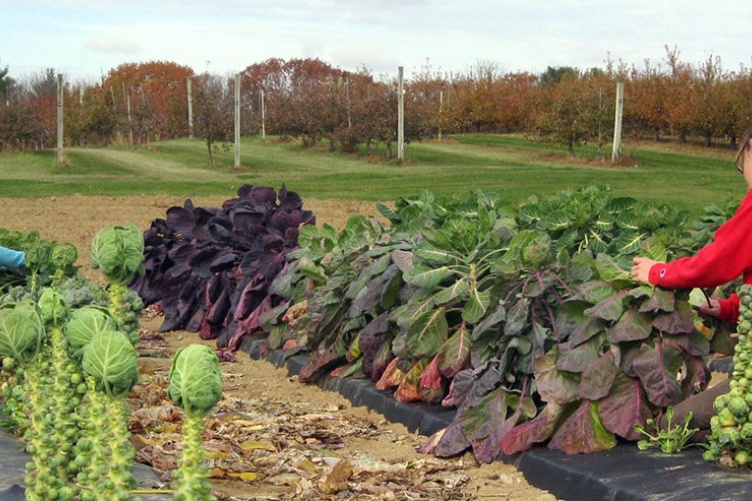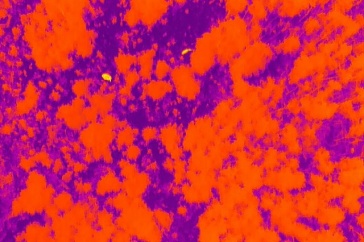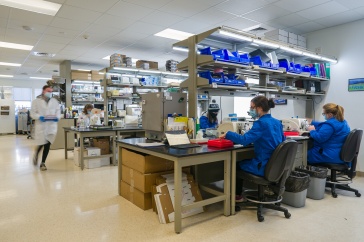
Different varieties of Brussels sprouts are being grown at the UNH Woodman Horticultural Research Farm to investigate which ones have the highest marketable yields for the region.
In the first study on growing Brussels sprouts in northern New England, a researcher with the NH Agricultural Experiment Station at the University of New Hampshire has found that different varieties of the vegetable perform much better than others, and the practice of topping has the potential to increase marketable yields.
The research was conducted by Becky Sideman, a researcher with the NH Agricultural Experiment Station and extension professor of sustainable horticulture production, at the UNH Woodman Horticultural Research Farm. The farm is a facility of the NH Agricultural Experiment Station.
“Brussels sprouts can easily be grown here, and the flavor of locally grown sprouts that have experienced some cold weather in the fall is sweeter than that of sprouts grown in warmer conditions. For those who love Brussels sprouts, knowledge of how to grow them here is a good thing. To my knowledge, this type of research hasn’t been done in this region before,” Sideman said.
Sideman evaluated nine cultivars of Brussels sprouts at the farm over two years. Of the five cultivars grown in both years, Nautic, Diablo, and Jade Cross E had good yields of more than 8 ounces per stalk. Of the cultivars evaluated for one year, Gustus, Early Marvel, and Octia were promising, with high yields on quality stalks.
“Many varieties of Brussels sprouts are available, and they show variable performance in our region. It would be expensive and time-consuming for farmers to grow all of the possible varieties to figure out which ones perform well, and which ones perform poorly, so we are trying to do that work and share it with growers,” Sideman said.
Sideman also investigated whether topping Brussels sprouts – removing the top of the Brussels sprout plant – increases the size of sprouts at the top of the stalk, thus improving marketable yields. “Extension recommendations about the practice of topping are also variable, and growers frequently ask whether or not they should top their sprouts -- and if they should top, when they should do it. We are trying to figure this out, so that we can make solid research-based recommendations,” she said.
She found that for some cultivars such as Diablo, Early Marvel, Gustus, and Jade Cross E, which are early and mid-season varieties, topping had the greatest positive effect. “The practice of topping has the potential to increase yields of Brussels sprouts, assuming a once-over harvest. It can also increase the attractiveness of each stalk, if growers are marketing entire stalks. However, topping too far in advance of harvest can reduce yields and marketability by causing plants to spend energy growing new stalks,” Sideman said.
Sideman will discuss these research results at the New England Vegetable and Fruit Conference in Manchester Dec. 15-17, 2015. Additional information on this research is available at http://extension.unh.edu/resources/files/Resource003914_Rep5563.pdf.
This material is based upon work that is supported by the National Institute of Food and Agriculture, U.S. Department of Agriculture, under award number 228522.
Founded in 1887, the NH Agricultural Experiment Station at the UNH College of Life Sciences and Agriculture is UNH’s original research center and an elemental component of New Hampshire's land-grant university heritage and mission. We steward federal and state funding, including support from the USDA National Institute of Food and Agriculture, to provide unbiased and objective research concerning diverse aspects of sustainable agriculture and foods, aquaculture, forest management, and related wildlife, natural resources and rural community topics. We maintain the Woodman and Kingman agronomy and horticultural farms, the Macfarlane Greenhouses, the Fairchild Dairy Teaching and Research Center, and the Organic Dairy Research Farm. Additional properties also provide forage, forests and woodlands in direct support to research, teaching, and outreach.
-
Written By:
Lori Tyler Gula, PhD | NH Agricultural Experiment Station | lori.gula@unh.edu | 603-862-1452



















































